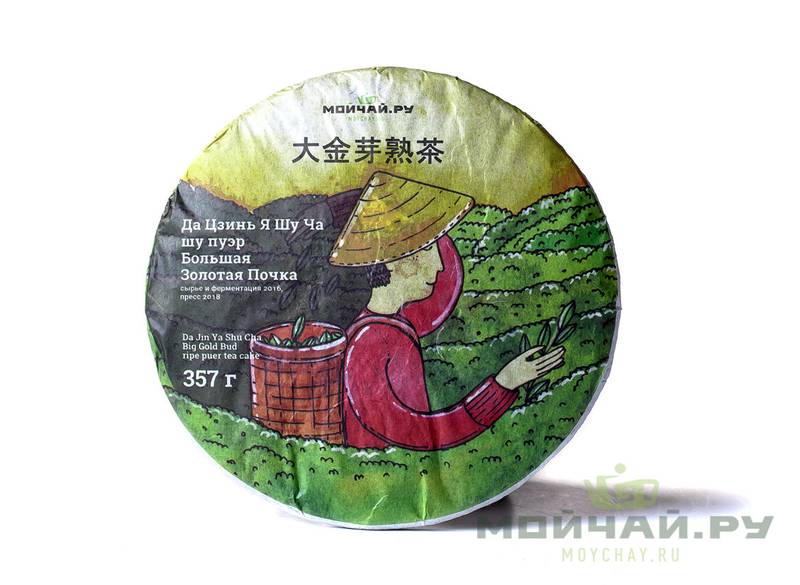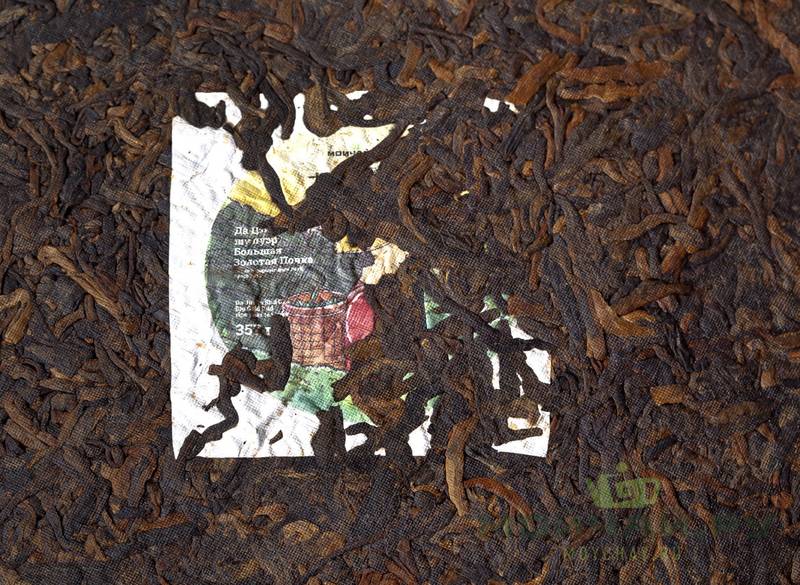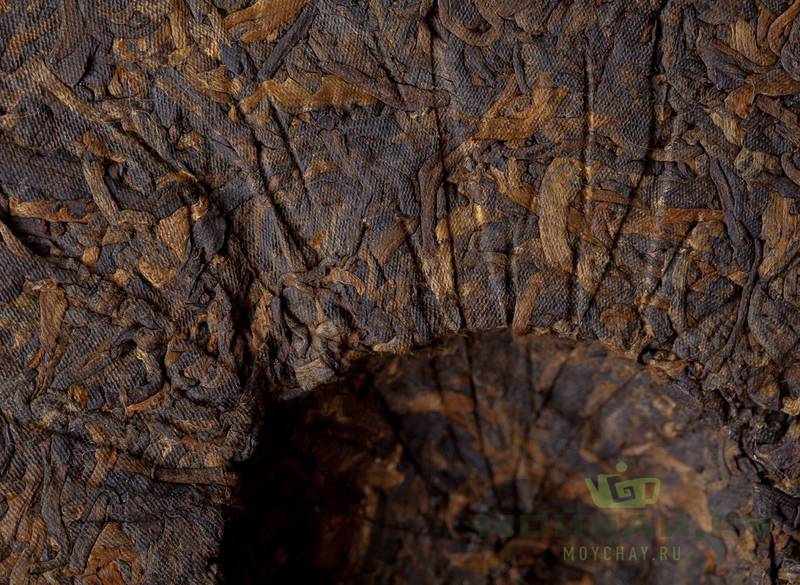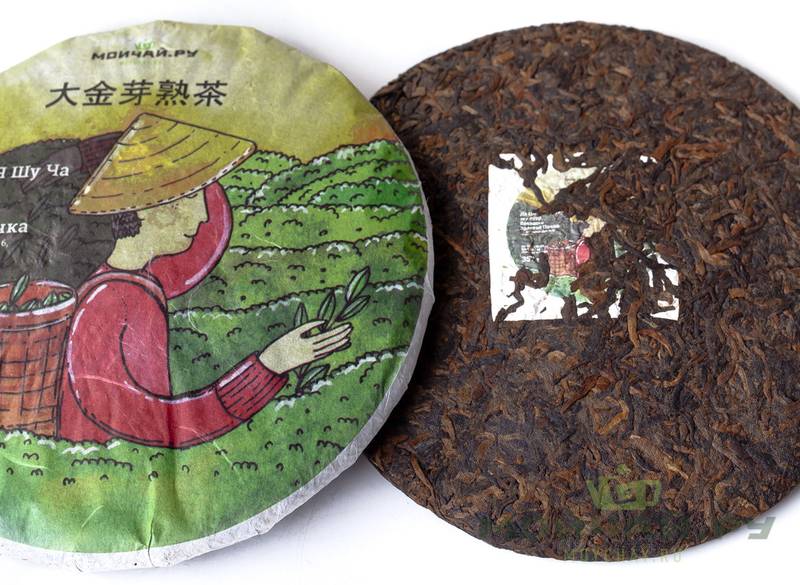This tea is listed as a Da Jin Ya Shu Cha (Shu Puer Big Gold Tips), a 2016 Menghai county harvested tea
pressed in 2018 From that Moychay site listing information it’s sold out now, no longer available. Too
bad; it was exceptional tea. At least the tea versions seem to be replaced by similar ones over time.

Review:
The first infusion is rich, creamy, full-flavored and delicious, already an exceptional version of shu even
though it’s hardly started brewing. It’s hard to place on a scale because shu being better than this must
still be possible but it tends not to come up often. An early start on breaking down a description to a
flavor list: the creaminess pairs with a sweetness, not completely unlike the flavor in Guiness Stout, a
variation of porter beer. The earthier range isn’t completely unlike that found in Guiness but the
comparison only goes so far; it’s different. That related / shared aspect is similar to a taste range found
in coffee, closest to a lighter roast version. Beyond that warm, earthy flavors span quite a range: dark
wood, tree bark (a clean version of it, integrated with the rest), extending onto aromatic spice range. It
will work better to unpack that spice range over the next couple of infusions, and tease out if the
sweetness resembles dark toffee most or something else.

It would be possible to drink this tea brewed quite strong, infused for 20 or more seconds prepared at a
standard Gongfu infusion proportion, with a gaiwan only a quarter filled initially (or a third with plenty
of empty space related to how the separated compressed leaf parts position), filled to two-thirds full
after leaves are wetted. It’s not best to drink it brewed strong, per my own preference. It works well
light, even very light, and to me best at a moderate strength, infused for just under 10 seconds at a
normal proportion. This lets the flavor stand out even more than a stronger (longer brewed) infusion
would, even though it’s counterintuitive that being lighter makes flavors more easily noticeable.
In the next round cocoa really stands out. It should have been listed on that first round too, it would
seem, but in this infusion it’s too dominant to miss. It’s not exactly as much like dark chocolate as some
teas can approximate, closer to the more earthy / slightly less rich flavor of processed cocoa, of a cooked
and dried version. It is quite sweet though, and also rich and creamy, so in that aspect range not so far
off dark chocolate, in comparison to how milk chocolate comes across. A hint of aromatic spice
underlies that too. It might be easier to identify if it transitions to be stronger, and my own scent-
memory for aromatic incense spices is limited (identifying sandalwood versus frankincense or myrrh),
but I’ll go ahead and guess that it’s closest to sandalwood.

This tea is so good that even this early on in tasting it’s interesting to consider what its limitations or
flaws are; how could it be better? The aftertaste could trail a little stronger, although that part is
pronounced. The feel is already full and creamy, but I guess the structure, the way that feel comes
across, varies so much that it could be different in a positive way. Not much better though; this works
really well on those levels, and shu tends to feel full and creamy but not usually as “structured” as some
other tea types. Same for flavor: the complexity is good, the range expressed is positive and novel, it all
balances together really well. The main room for improvement that stands out could be a preference
for different range, for someone not liking shu, or disliking the dominant cocoa aspect. That would
seem like a strange preference range, to me, to not like shu, or a shu that tastes like cocoa towards dark
chocolate. Not seeing cocoa as one of someone’s most-preferred tea aspects somehow seems more
reasonable.
The next round is similar but the flavor profile did evolve. It picked up more complexity, and the soft
sweetness folded in a bit more light earth, a short step away from cocoa and spice, back towards the
lightly roasted coffee range. That works too; maybe even better. Earthy mineral range seems to stand
out more as a foundation for the rest, just a faint hint of the slate-mineral that is a dominant flavor in Liu
Bao (a type of hei cha, or dark tea), although in this shu version it is just a supporting aspect.
That works an answer for how this could have been improved; transitioning to include more flavor
aspect range that works well into the balance, as just occurred. It might be nice if it tasted even more
like cacao, to me, if that one particular sweet richness in the nibs (roasted / fermented bean fragments)
or in bean-to-bar dark chocolate came across more, versus the drier, earthier flavor of processed cocoa.
Or more fruit would be nice; there’s probably a hint in this I haven’t described, overlooked to focus on
the other dominant aspects, maybe in the range of dried dark cherry. Or that flavor could be in
between fresh dark cherry and a dried version.
It doesn’t transition much on the next round. Shu doesn’t express changes to the same extent some
sheng does, and this may well stay about the same for a few rounds before lengthening infusions slightly
after the 6th or 7th alters the aspect balance. It might sound like a lot going on given the length of that
flavors list: cocoa, dark wood, trace of tree bark, light roasted coffee, creaminess—as a feel and related
to flavor, light aromatic spice, underlying slate mineral, and dark cherry. It comes across as simple
though, since it all integrates as a related complex set, as well-balanced and easy to drink.
That simplicity and approachable nature might be what some would see as a flaw; that it’s not quite
edgy and challenging enough. Some tea types contain interesting aromatic compounds, in some cases
resembling liqueur or perfume; this isn’t like that. Adding just a touch of tar to this profile might
counter the rest in a novel and pleasant way. Or ramping up feel-structure, but it’s asking a lot for a shu
to not just be smooth and rich, complex in feel structure in addition to just being full in feel. This is how
good shu versions generally are related to the mouthfeel aspect, maybe just a little creamier, or with a
hint of resinous texture in some versions.
Aging this tea for years would probably fade that flavor intensity to some extent, and cause it to gain
more subtle smoothness and richness related to the feel complexity. It might not change much; this tea
is great as it is. After another year it might round off flavors just a touch and pick up just a trace of that
feel complexity, and that could be enough aging transition. It’s definitely not “off” in any sense now, not
showing fermentation-process related flavors that fading through aging would improve (tar, petroleum,
peat, etc.).
The next infusion is the same, perhaps thinning a little. Ramping up infusion strength would
compensate for that, and keeping the water hot (full boiling point) would draw out as much earthy
aspect range and feel structure as the tea potential allows for.
All in all it makes for a very nice tea experience. Shu version aspects sometime vary across a narrower
range than some other tea types but this one was novel and very pleasant.
